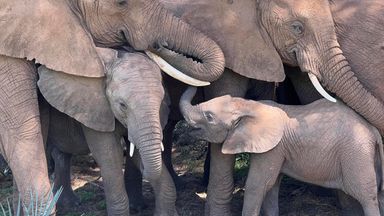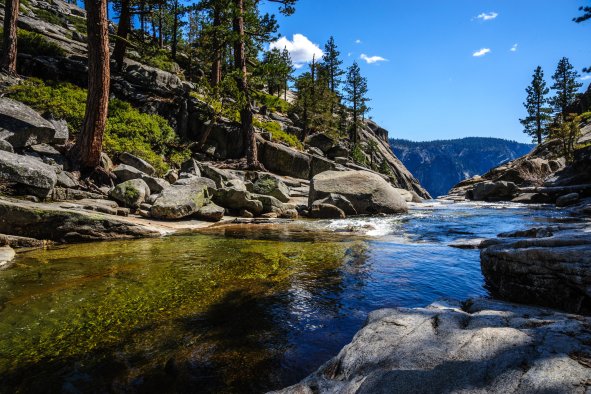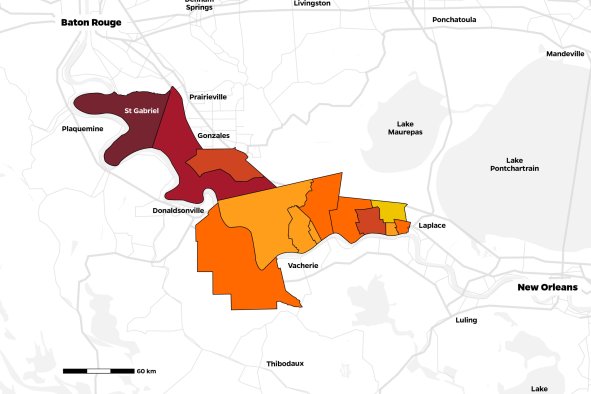About 200 yards offshore of North Miami Beach, an underwater experiment is underway. An artificial reef called "the Sea Hive" will test how a blend of manmade and natural defenses can help protect some of the nation's most valuable waterfront property against the battering waves of tropical storms.
The Sea Hive is a stacked pyramid of 12-foot-long hexagonal concrete tubes submerged in about 30 feet of water. In cross-section they resemble the pattern of a beehive—thus the name—and openings along the sides allow water and wave energy to enter.
"Because of their perforated nature they do a really good job of mitigating wave height and wave energy," University of Miami Associate Professor of Marine Biology Diego Lirman told Newsweek. Lirman is part of a team of engineers, biologists and social scientists developing the coastal defense project that mixes the "gray" of concrete and the "green" of nature-based solutions—in this case, corals.
Corals are Lirman's focus. His lab works to grow and restore corals in South Florida waters and the Sea Hive is intended to act as both a wave barrier and a base for coral growth. In lab simulations, Lirman said, the concrete structure alone reduced wave energy by 60 to 70 percent,a potentially valuable addition when storms erode the beach and threaten beachfront property.
"But the really cool outcome is that by adding corals, especially using branching corals that cause a lot of friction, you can increase the benefit by anywhere between 10 and 20 percent," he said. "It gives support to this idea that hybrid approaches are much better than just deploying a whole bunch of 'gray' infrastructure, which is what we've done in the past."
The summer of 2024 is shaping up as a big test for the Sea Hive. Sea surface temperatures have been pushed higher by climate change and the recent El Niño weather cycle, further threatening corals and fueling what forecasters expect to be an extraordinary hurricane season.
Hurricane season starts in June and the National Oceanic and Atmospheric Administration warned that up to 25 named storms and four to seven major hurricanes are likely this season.
Lirman said he also expects another coral bleaching event this summer, on the heels of a mass bleaching event last year. Bleaching occurs when corals are stressed—usually by extreme temperatures—causing them to lose the microscopic algae that provides both their food and color.
A coral might recover from a single bleaching event, but they are left weakened without that symbiotic algae, and the stress of multiple events can kill corals.
"At this point, it's just a question of how bad it will be," Lirman said grimly.
South Florida is arguably America's ground zero for climate change impacts, where coastal cities like Miami face a mix of extreme heat, sea level rise and stronger storms.
The surrounding ecosystems such as coral reefs can help buffer some of the effects of storms and coastal erosion, but climate change threatens them as well.
"Our coral reefs have lost much of their structure, especially after the 2023 mass bleaching event that decimated corals up and down the Florida coastline," Lirman said. "When you lose corals, eventually you lose structure, and you need that structure to slow down the waves."
Lirman and his colleagues are racing to help corals survive warmer waters and, in turn, support the corals' ability to help shoreline communities cope with climate change.
Reef Rescue in Warming Waters
"We were not counting on back-to-back bleaching events in consecutive years," Lirman said, but with elevated water temperatures persisting and South Florida recently baking through early heat, his lab is already preparing for another year of coral rescue.
Last summer's record-high sea temperatures triggered what scientists called the most extensive coral bleaching in state history. Coral restoration workers rapidly worked to move the rarest and most vulnerable specimens, in some cases removing them from the reef nursery and transferring them into tanks on land.
"If you think about that, that's messed up," Lirman said at the thought of moving sea life from the water to save it. "But you have to send your researchers out to save the dodos, to save the last remaining members of a species or a genotype."
Lirman's lab also uses the ocean heat waves as natural experiments to better understand which corals can best withstand heat or rebound from bleaching.
"What doesn't kill you makes you stronger on a reef," he said.
Through selective breeding and other genetic techniques, the lab researchers are producing corals that could have a better chance of surviving the next bleaching event.
"The idea is not to go out and plant the next wave of victims, but to be selective in terms of what we grow," he explained.
The Limits of Adaptation
The Sea Hive experiment will soon expand thanks to funding from the Defense Department and its Defense Advanced Research Projects Agency. DARPA, as it is known, invests in national security technology and its work often has impacts well beyond the Pentagon—DARPA gave us the internet, among other things. Still, corals and marine barriers seem a bit far afield for the military.
"It is kind of a strange funding source for this type of work," Lirman said, but the coastal nature of several military installations makes climate-driven storms a national security issue. "They realized they wanted to protect their infrastructure, and some of their Naval bases and Air Force bases are heavily impacted by storms."
Projects like the Sea Hive show promise to enhance the resilience of coastal communities, Lirman said, and he remains hopeful that his lab's research will help corals adapt to some degree of warming. But he warns that adaptation efforts, while very important, are not solutions by themselves.
"Job one is if we don't fix climate change drivers, no amount of mucking around with the coral genome or selective breeding or any of those things will matter," Lirman said.
Most scientists agree that greenhouse gas emissions must come down, and quickly, if the world is to meet the globally agreed-upon targets to avoid the worst warming.
Lirman's work and home both sit at the forefront of climate impacts. His school's mascot might be the Hurricanes, but that does not make the University of Miami associate professor a fan of the storms. Climate scientists warn that hurricanes are likely to become more intense with warming and South Florida's fate is uncertain if sea level rise continues unabated. The animals he works with are also at risk, as coral reefs are among the global ecosystems most sensitive to climate change.
"We don't have a lot of time, so we need to act very quickly and with a purpose," Lirman said. "But I still think there is reason for optimism."
Disclaimer: The copyright of this article belongs to the original author. Reposting this article is solely for the purpose of information dissemination and does not constitute any investment advice. If there is any infringement, please contact us immediately. We will make corrections or deletions as necessary. Thank you.



